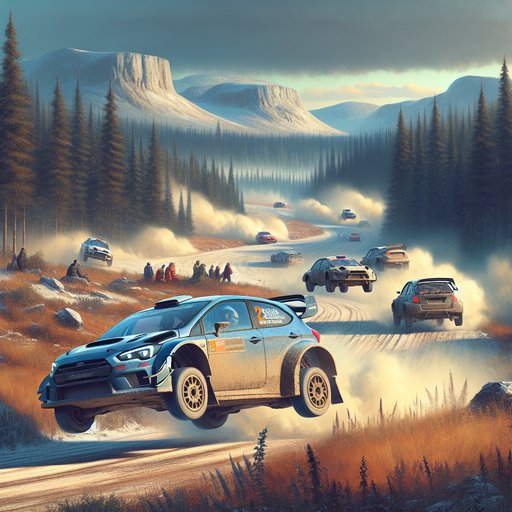
The great rally cars wore ordinary badges. They rolled out of dealerships with shopping bags in their trunks, and then, with thicker springs, extra lamps, and a roll cage, they went hunting across ice, gravel, and volcanic ash. From the Saabs and Minis that dug studs into the Alps to the Polos and Yaris that later carved arcs at 200 kph through Finnish pine, mass-market makes kept finding speed in unlikely places. The stages changed, the rules evolved, and the technology marched on, but the road-going ancestry of rally’s heroes gave them their bite—and gave spectators a reason to point from a windswept bank and say, that looks like my car.
At Monte Carlo’s dawn in the 1960s, the service park smelled of coffee and two-stroke oil. Saabs and Minis huddled on icy tarmac, their doors thudding shut as mechanics warmed gloved hands over little engines that would soon be howling up snow-lined passes. On those early mornings, it felt plausible that a family car, painted in team colors and bristling with lamps, could sneak past Porsches and big saloons by picking better lines and bouncing off the banks with more bravado. That plausibility hardened into proof.
Saab’s compact 96, a neat front-drive capsule from Trollhättan, slid to back-to-back Monte Carlo wins in 1962 and 1963, carving neat arcs under Erik Carlsson on snow that swallowed heavier, faster machinery. A year later the Mini Cooper S, nominally a city car, scampered to the top step with Paddy Hopkirk, its short wheelbase flicking from hairpin to hairpin while spectators leaned into the cold and the car’s twin spotlights burned holes in the night. These were not exotic machines; they were everyday silhouettes, repurposed with cunning. As the decade turned, mud began to define the story.
Ford’s Escort, a modest saloon with a square jaw, stacked two fog lamps and went looking for continents. In 1970, an Escort RS1600 survived the London to Mexico marathon; in British forests, the car’s bark was as common as birdsong. On the RAC Rally in 1972, Roger Clark did what enthusiasts had begun to expect: he sent an Escort down slick lanes with such commitment that the car looked like it was hinged in the middle, and the stopwatch agreed. Far away on the other side of the equator, Volvo’s PV544 and later the Amazon braved the Safari’s flood-swollen fords, and Datsun’s 240Z hurled itself across the Rift Valley to win in 1971 and again, with Shekhar Mehta at the wheel, in 1973, proof that sensible badges could shrug off savage roads.
The 1970s also let a family saloon wear racing shoes and win titles outright. Fiat’s 131 Abarth arrived as a crisply folded box from Turin and left as a triple world champion, its twin-cam engine and multi-link suspension turning car parks full of 131s into unintentional tributes. On Corsica’s ribbons, it threaded photo-postcard villages; on the Acropolis, it hammered through rocks with dust boiling to the sill line. Lancia’s Stratos, a purpose-built wedge from the same parent company, stole the headlines with its alien form and three straight manufacturers’ crowns, yet the humbler Fiat underlined the premise: a car that started life as a family sedan, carefully reworked, could dominate any surface.
Then four driven wheels redrew the map. Audi’s Quattro was the idea you could fetch groceries in and win rallies with, differentiated by its diffs. In 1981, in Sweden’s ice and snow, it took its first world rally win, its turbocharged five-cylinder throwing a brazen yowl against the drifts while the car hauled itself out of corners as if tugged by a rope. The quattro badge began to appear on road cars everywhere, and on rally stages it transformed exits from patience into violence.
Meanwhile Peugeot—the maker of sturdy bicycles and suburban hatchbacks—hid spaceframe witchcraft beneath a 205 silhouette and let the 205 T16 turn Group B into déjà vu: stages finished with marshals shaking their heads, spectators replaying launches on their retinas, stopwatches recording the inevitable. From 1985 to 1986 the little Peugeot, all ducts and wings, took both major titles and left gravel quivering in its wake. When Group B’s fire burned out in 1986, the sport pivoted back to cars more closely tied to the showroom, and the lesson endured. Lancia returned from futurism to familiarity with the Delta HF Integrale, a boxy hatch that collected six manufacturers’ titles and became a neighborhood hero, often seen parked tight against stone walls beneath laundry lines in Italian towns.
Toyota turned the Celica GT-Four into a world-beater, linking Monte Carlo hairpins to dealership brochures with wins and titles in the early 1990s. On the blue-and-yellow canvas of Subaru’s Impreza 555, anti-lag crackled against dry stone walls, and in 1995 a young Colin McRae delivered the drivers’ crown, the car’s flat-four warbling through Welsh forests. Mitsubishi’s Lancer Evolution, hardly a luxury badge, kept its own relentless beat under Tommi Mäkinen and claimed four straight drivers’ titles from 1996 to 1999; in 1998 Mitsubishi also took the manufacturers’ title, a red saloon that looked at home in a school run and a Scandinavian flick. The 2000s crystallized an odd truth: the humblest shapes often carried the sharpest edges.
Citroën rolled out Xsaras and later C4s that looked like company cars with ironclad punctuality; Sébastien Loeb’s precision turned them into metronomes, and record books yielded. Ford’s Focus WRC, a five-door hatch born in rental fleets, claimed manufacturers’ titles in 2006 and 2007, proving that a swing-tail hatch could make forests into fast-forward. In between, the Impreza returned in different guises, Mitsubishi flared and faded, and the names on the doors remained household words in more ways than one: Sainz, Grönholm, Solberg—drivers who shared their surnames with neighbors’ mailbox plates in the countries where their cars were sold. After 2010, the silhouettes shrank and the pace sharpened.
Volkswagen, a company better known for Golfs under commuter traffic, engineered the Polo R WRC into a surgeon’s scalpel and sliced through the championship from 2013 to 2016. Sébastien Ogier was the pilot, but the badge mattered; people in town watched Polos pass and thought of Finland’s crests and the car’s stability over blind brows. Hyundai returned as an upstart with a family hatch, refined it year by year, and—against Toyota’s resurgent Yaris—took back-to-back manufacturers’ titles in 2019 and 2020, validation for a brand that built more compacts than posters. Skoda, a company once synonymous with sensible sedans, turned the Fabia into the benchmark in Rally2, filling regional and WRC2 entry lists with green-and-white squares and making privateer service parks look like factory annexes.
The thread that ran through it all was not romance but utility. All-wheel drive migrated from rally stages to suburban cul-de-sacs because Audi proved it in dirty boots. Turbos, intercoolers, and clever differentials became dinner-table words in the homes of people who kept brochures for Quattros, Integrales, Celica GT-Fours, Impreza WRXs, and Lancer Evolutions next to the phone. Even the oddballs felt close to the curb: Renault’s 5 Turbo, with its mid-mounted engine stuffed where shopping had been, still looked like a supermini in a funhouse mirror, and it won Monte Carlo in 1981 by beating the mountains at their own game.
The stronger the link to the showroom, the more the crowd believed that the world’s worst roads were fair game for anyone brave enough to point a familiar bonnet at the horizon. By 2022 the sport had sketched a new silhouette again, Rally1 hybrids yielding spaceframes under familiar names: Toyota GR Yaris, Hyundai i20 N, Ford Puma. Under the composited bodywork, the connection to a finance plan was mostly philosophical, but it persisted on the surface. The badges were shared with commuter lanes and high streets, the headlights echoed on five-figure cars, and the roar—now overlaid with electric whine—flowed down from mountain passes to dealership lots.
In a Finnish lay-by, a kid pressed nose to glass at a GR Yaris and mouthed, that one flies. In Wales, a Puma’s tail-lamps flickered through rain two ways: in showrooms and in stages. Rally’s most successful cars kept ordinary company and made that ordinariness extraordinary. The sport asked mass-market engineers to build for impact after impact, then it let customers sample the result by turning a key and feeling the steering wheel shuffle under torque.
The settings changed—Alpine passes, Kenyan steppe, Greek rock gardens, Swedish dawns—and so did the regulations, but the electricity in the snowbanks stayed the same. A familiar badge on a mud-thick bonnet still brought the crowd closer to the tape, and a distant road test still felt personal when the car on the cover shared its name with the one in the driveway. The lesson held steady across decades: the world’s fastest roads favored the cars people knew.








































